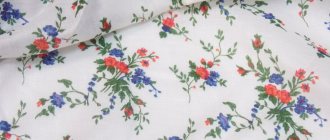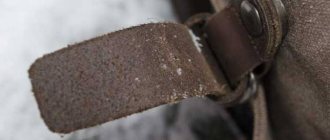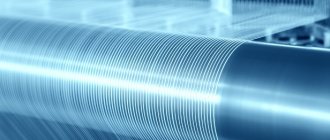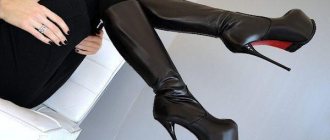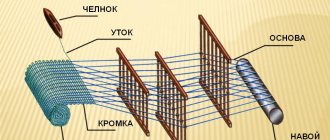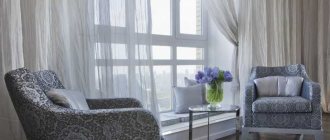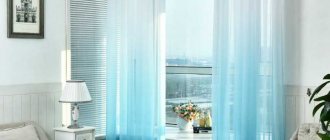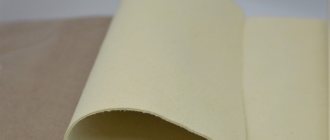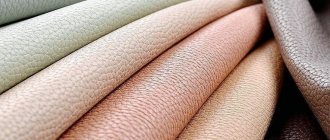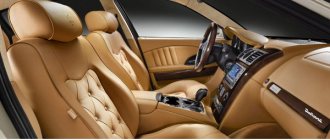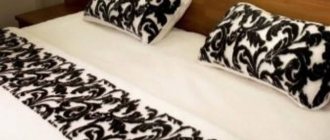Saffiano leather products are the subject of heated debate. All thanks to the ambiguous type of material and the confusing history of origin. Morocco has been known since ancient times.
Morocco boots are mentioned in Russian epics and chronicles of the 10th century, where they are contrasted with bast shoes as a sign of belonging to the aristocracy. Shoes were made from goatskin, which was distinguished by its softness, pleasant velvety texture and bright color (most often red). Modern Saffiano has little in common with ancient morocco. A distinctive feature of the material is its specific fine embossing.
Description of saffiano leather
Saffiano leather, common these days, has Italian roots. The patent for "Saffiano" belongs to the world famous brand "Prada". Back in 1913, the company released a handbag with a specific branded embossing. Photo:
The interesting texture added originality and practicality to the bags. The morocco surface does not scratch or wear off. Leather products can last 10 years or more, maintaining an excellent appearance. Even then the material was appreciated. Bags, wallets, and other leather goods were made from it.
But the real “morocco boom” came in 2012, when global brands unanimously released a series of accessories with characteristic embossing. Love Moschino, DKNY, Michael Kors handbags immediately found a response in women's hearts. They were dreamed about, wanted, and bought en masse by women of all ages.
Saffiano leather – natural material or not?
Initially, saffiano is genuine leather. According to the definition:
Saffiano leather is a textured calfskin that is resistant to stains and scratches.
It is thanks to its texture with diagonal fine embossing that the material acquires high strength and resistance to abrasion and scratches. On the other hand, such a finish makes it look like leatherette. The rough surface is not as pleasant to the touch, and, according to some people, it looks “cheap”.
Please note that natural saffiano leather is often counterfeited. An explosion of popularity in 2012 gave rise to the production of materials with a similar texture. In this regard, many began to distinguish the morocco effect:
If the material simply says “Saffiano”, it means it has been hot stamped (a “ribbed” or other pattern has been applied).
By the way, similar embossing can be seen on the covers and bindings of books. This is not genuine leather, but a polyvinyl or polyamide substitute (lederin or other).
Basic properties of leatherette
The properties of leather made from polymer materials vary depending on the technology of its production. Modern developments have made it possible to create materials that are resistant to frost and even fire.
General properties of artificial leather:
- hypoallergenic. Leatherette is completely safe for the human body. It does not emit substances that can cause allergies;
- permeability. Modern artificial leather does not cause a greenhouse effect. The latest technologies have made it possible to make it “breathable”. Thanks to this, the material maintains a constant temperature. It does not overheat in the sun and does not harden in cold weather;
- softness. Artificial materials are very pleasant to the touch. They are distinguished by softness and tenderness;
- wear resistance. Leatherette can last for more than one year. If previously leatherette clothes had to be thrown away after a season, now they last for decades;
- nice smell. Innovative manufacturing techniques have eliminated the unpleasant odor from leatherette.
When choosing artificial leather, you also need to pay attention to such a property as density. It differs for different leatherette samples. This indicator determines the strength and scope of use of leatherette.
Compound
Saffiano leather is made mainly from calf skins, less often sheep skins.
Cattle calf leather is considered the highest quality and most valuable. It is soft, does not crack at low temperatures, does not break at bends, does not wear out for a long time, and can withstand heavy loads perfectly. Sheep leather is slightly inferior to calfskin in strength. Otherwise, it is of the same quality and is widely used for the production of expensive bags and wallets.
Saffiano is made as follows:
- Animal skins are soaked and cleaned of dirt.
- They perform liming and sodding - removing hairs and trimming wool.
- The subcutaneous fat layer (flesh) is removed.
- The raw materials are deashed and washed thoroughly.
- Next comes tanning.
- The finished semi-finished product is leveled in thickness, folds are smoothed out, and painted.
- Morocco embossing is performed on a special machine at a temperature of 160-170 degrees.
- Finally, the front surface is covered with finishing waxes.
To reduce the cost of saffiano leather products, skins with defects can be used. Hot stamping allows you to hide them. Substitutes with the “morocco” effect contain polyurethane.
Types of leather substitutes
There are materials that are similar to leather in structure and appearance, but are not leather. They are called leatherettes.
Leatherette is an artificial material that creates the appearance of natural leather . It consists of several layers. Leatherette is used in various fields of production. Most artificial substitutes can hardly be distinguished from natural material: they withstand moisture and frost. Leatherette is popular because it is inexpensive, practical and durable .
Types of leatherette: How to distinguish
- Vinyl leather is a durable material, has good elasticity, is prone to draping, and completely imitates natural matter;
- Dermantin is an artificial material. It is resistant to abrasion, has a slight odor, and is cheap;
- Eco-leather is a soft material, resistant to wear, breathable, has good elasticity, does not crack, does not smell.
Features of eco leather
Few people know what eco-leather is on shoes and how to distinguish eco-leather from genuine leather. Eco-leather is made from a cotton base, on which is applied : it imitates natural matter, and thanks to the base, the material becomes resistant to abrasion, stretching and tearing.
Its main advantage is that it is environmentally friendly (hence the name), because no animal is harmed during its production, and during use it does not emit harmful substances into the air. It is hypoallergenic. This material is resistant to moisture and does not let it in, but at the same time the foot breathes in it. And in shoes made of eco-leather you will be comfortable in all weather conditions. It creates a complete imitation of natural matter, costs less than leather products, but also lasts a long time.
Characteristic
The material has a lot of positive properties. But above all, it is valued for its wear resistance. Characteristics of Saffiano leather:
- durable;
- dense;
- resistant to cuts, scratches, abrasion;
- has little elasticity;
- holds its shape well;
- resistant to moisture and dirt.
The material has few disadvantages, and they are all mostly subjective:
- Morocco wood does not allow air to pass through well. High density and embossing impair air circulation. Shoes and clothes may not be too comfortable and stuffy. Combining with natural suede, leather and fabric saves the situation. But it is worth noting that shoes, boots and jackets made of morocco are rare. Leather is primarily used for the production of leather goods.
- Saffiano leather does not look like genuine leather. This is true. Embossing completely erases the “face” of the skin – the pattern is diminished. The finishing also destroys the characteristic leather smell. Nevertheless, many people find morocco very attractive and original.
The material has one significant disadvantage - natural saffiano leather can easily be confused with a polyurethane substitute for saffiano leather.
Outerwear made from compressed material
The advantages of shoes made of genuine leather are obvious, but what can be said about outerwear?
Cloaks, skirts, trousers and jackets made of pressed leather often look very attractive and dignified. The decision to purchase and use them is best made based on factors such as the amount of money available to purchase the product; how the purchased item will be used in the future; characteristics of a particular human body.
If leather clothing is intended for active, constant wear and there is a desire to use the item for a long time, then if finances are limited, it may make sense to save up for a product made of genuine leather. You can take a closer look at the assortment of natural materials that are not of the highest class - a little more coarsely processed or made from less expensive raw materials (the skins of different animals can have a huge difference in cost).
However, if the item is trendy, designed for one season, or this outfit is rarely in demand in the wardrobe - perhaps it is needed solely for a beautiful photo - pressed leather will allow you to achieve your goal at an affordable price, without having any negative impact on the body.
Morocco bags – what are they?
Michael Kors has been actively using saffiano leather in its collections for many years. The brand, in a sense, became associated with morocco. Casual, formal office bags, wallets, clutches, crossbodies - you can choose a model to suit every taste.
You can see saffiano leather on bags from such famous fashion houses as Prada, Furla, Cerruti, Celine, Burberry, Salvatore Ferragamo, Gucci, Dolce & Gabbana, Cerruti, Paul Smith. As a rule, they produce the same bag model from different materials.
It's not just luxury brands that use embossed leather. Bags and accessories made from it are found in the collections of relatively modest companies Fabi, Baldinini, Le Tanneur, Longchamp, Enquer, Brooks Brothers, Montblanc and others. Saffiano leather backpacks and belts are also produced. Sometimes it is combined with other materials.
Saffiano leather products
Famous world brands include morocco in their collections and love to work with it, as it adds uniqueness and originality to their creations due to the heterogeneity of its structure.
She is loved by Prado, Furla, Cerutti, Gucci, Dolce&Gabbana.
Lesser-known design companies specializing in the production of leather goods use it from time to time: Enquer, LongChamp, Tuscany.
Note! Fabi and Baldinini, popular in Russia, sometimes spoil their fans with morocco goods.
It is beneficial for manufacturers to use “saffiano leather”, since, having once purchased such an item, the buyer will be captivated by its quality, durability, and will come back to the same store for the next similar product. Such information spreads quickly, attracting new customers. The price of a branded item is not low, but the quality speaks for itself. Durability, richness of colors, beauty of models make you forget about the money spent on purchasing the product.
Well-known companies producing Saffiano leather are Ilcea, Annonay.
Types of products made from saffiano leather:
Bags
Bag models captivate with a variety of colors, styles, and designs. Fashionistas will be able to choose any option to suit their taste. The practicality and quality of the source material can only please you.
Bag
Clutches, wallets
A clutch is an indispensable item when creating a classic, formal look for parties or going to the theater. What could be better than a clutch made of genuine sheepskin with an original finish.
Wallet
Wallets are a stylish addition to your wardrobe. How nice it is to take out a morocco-style wallet from a handbag or men's briefcase, especially if it is an original item.
Inner surface of the wallet
Cases, suitcases, travel bags
Such a thing will give status and originality to the owner. Their cost is high, but reliability and long service life justify the costs.
Travel bag
Shoes
Every fashionista dreams of having Prada shoes. Chic models, recognizable style, comfortable lasts - all this is Prada. And if you add them with a handbag or wallet, your dream will come true. The whole world is at the feet of the owner.
Men's footwear
Reviews
Saffiano leather products are not for everyone. This conclusion can be drawn from mixed reviews on the Internet:
Victoria M.:
“When I first bought a Michael Kors saffiano leather bag, I had no idea that it was a great investment. I spent 10 thousand rubles. As a result, 5 years have passed, and the bag is like new. True, I have two other bags for my shift. But even if you only wear it day after day, it seems to me that the condition will not change. I don’t know how they achieve such quality, but it really justifies the high price.”
Natalya Klimenko:
“A very good bag, I would say indestructible. It doesn't rub and washes well. Regarding whether the leather is genuine or not, a person working at a leather factory said that now the fake is of such high quality that an ordinary person would not be able to tell the difference in life.”
Amina:
“The quality is good, yes. But I still don't really like my Saffiano leather Donna Karan. It reminds me too much of polyurethane.”
Larisa:
“I recently received a Michael Kors bag and was really disappointed. I always really like the smell of leather. And this morocco smells nothing at all. As I understand it, this is due to special processing. So you can see that the leather is natural, good quality. I liked that it holds its shape well. You can wear it. But it didn’t create a “wow” effect.”
Haberdashery faux leather
Haberdashery leatherette is used to make various accessories: key holders, wallets, cases, and so on. It is produced by applying PVC to viscose-lavsan, cotton or polyester fabric. Thanks to this, leatherette acquires such properties as:
- softness and tenderness;
- ease of processing;
- resistance to mechanical damage (tensile and bending strength);
- wear resistance.
The service life of a leatherette product depends on the structure of the material. For each accessory, the type of leatherette that is most suitable in terms of performance characteristics is selected. Haberdashery leather also has good frost resistance. This is important for the production of gloves, for example. Therefore, they cope well with temperatures down to -25° C.
What about morocco boots?
Many people know about morocco boots from old films and books. They were worn by “good fellows,” merchants, princes and the entire wealthy class. The boots looked bright red, multi-colored, embroidered with gold, often lined with iron shoes, with an upturned toe. Women's boots were called morocco boots. For commoners they were a luxury.
For sewing boots, specially tanned leather was used - morocco ("sofyan" is an erroneous spelling). According to the definition:
Saffiano is an ancient type of leather, vegetable-tanned from goat skins and dyed a bright color. Currently not in production.
According to one version, morocco was named after the Moroccan city of Safi. The national footwear of Morocco, babouches (shoes without backs), was made primarily from embossed morocco. One way or another, the material was brought to Russia from other countries. Later, in 1666, its own production was opened. The technology was incredibly complex:
- Goat skins were soaked in water and then in ash pans.
- After the hair began to separate, it was collected on a block.
- The skins were returned back to the ash pit for 1-2 weeks to produce fat.
- The raw materials were flayed, and the front side was carefully shaved and made smooth with a stone.
- At the next stage, the canvases were washed under running water in special rotating barrels.
- For a flawless “face,” the skin was placed in wheat jelly, washed and passed through several vats of sumac juice.
- Then the sumac plant was tanned.
- After tanning, morocco was dyed in bright colors. Natural dyes were used - plant or animal (for example, cochineal mealybug). To ensure color stability, the leather was etched with a warm solution of stannous chloride or alumina mordant.
- Finally, the painted and dried leather was given a gloss finish. The surface was smeared with a mixture of dye, beaten egg whites, linseed oil and passed with force through a glass cylinder.
Sometimes a pattern was rolled onto the skin with a roller. Morocco boots were considered the best shoes and cost fabulous money.
Less commonly, furniture was covered with morocco and book bindings were made from it.
Mention of the material in the literature:
- “I put on morocco boots with carved designs of all sorts of colors.” Gogol, “Dead Souls”.
- “Like girls, in an elegant headdress of yellow, blue and pink haircuts, on top of which a gold braid was tied, in thin shirts embroidered along the entire seam with red silk and studded with small silver flowers, in morocco boots on high iron horseshoes, smoothly, like peahens, and with a noise like a whirlwind, they galloped in the turtle dove.” Gogol, Evenings on a Farm near Dikanka.
- “The red wide morocco sofa obviously served as Rogozhin’s bed.” Dostoevsky, "The Idiot".
- “These soft-bound books made of delicate green morocco are still with me.” Kuprin, “Sentimental Novel”.
Today, morocco products can only be seen in museums and ethnic exhibitions. They are part of history.
Saffiano leather - what is it from history
Morocco until the 18th century. used to make expensive shoes. The main material is goat skins, which were hand-tanned with the sumac plant (translated from Latin as “Rhus”). Then it was painted with bright dyes based on natural ingredients (mostly red, it was obtained from cochineal insects). The finishing stage is polishing the outer surface with beaten egg whites, linseed oil, and a wax-based aqueous coloring solution. The last finishing stage made the leather reliable, moisture-resistant, resistant to tearing and cracking.
Different colors of material
For your information! The name “Safi” comes from the African word “Asfi” (translated as “river flood, its mouth”). The birthplace of the material is Africa.
The material was brought by ships from Africa to European countries. Due to the long and dangerous delivery by sea, its cost was high, so subsequently Europe began to produce saffiano leather itself, but sheep and cow skins were used as raw materials, which significantly reduced the cost of the tanning process.
In Russia, because of the high cost, such shoes were worn by the upper class, boyars, and noble gentlemen. Boots were considered a symbol of nobility and money.
In 1666, the first production of polyvinyl saffiano leather was opened in Russia, but even then not everyone fully understood what it was. The basis of production at the opening was book bindings. Later, shoe production was mastered.
Binding
Over time, Saffiano leather lost popularity and was forgotten, as it was replaced by cheaper, easier-to-process materials.
You might be interested Features of madapolam: use of fabric
Note! The famous world designer M. Prada gave a new peak in popularity to this type of leather in 2012, being the first to release an original collection of bags.
Nowadays, stores selling clutches, wallets, cosmetic bags, suitcases, cases, belts, and shoes made from saffiano leather. Since it is used by famous design houses, the price of the products is high. The buyer has to pay not only for a quality item, but also for its brand. The more famous a company is in the field of manufacturing things, the correspondingly higher the cost of its products. And if an item is made in a single copy or to order, then the price increases tenfold.
Bags
Sheep and calf skins are used to make Saffiano leather. It is hot stamped with a diagonal pattern (small scar). To avoid contamination, cracks, and tears, the material is treated with a component containing wax. It increases the service life of the material, which increases its resistance to mechanical stress.
The final result depends on the quality of the raw materials. To reduce the cost of the production process, surface parts of the skin with defects are used, which are retouched by applying a pattern. For cheap material, polyurethane is used as a raw material.
A lot depends on the quality of the dyes for the wax coating. The use of completely synthetic dyes and non-natural wax reduces the cost of production technology, thereby making the morocco unnatural.
The texture of saffiano leather, as discussed above, looks unusual. Its outer surface differs from natural, so many people think that it is artificial.
Leather
Questions and answers
Question: How to properly care for the material?
Answer: Saffiano leather does not require lubrication. Caring for it comes down to wiping with a damp cloth. It is recommended to use a microfiber cloth, which best absorbs dust and dirt. If your bag suddenly gets wet from rain, you can dry it away from heat sources in a dry, ventilated area. If after drying it becomes rough, a special moisturizing balm will help save the situation.
Question: How to distinguish natural saffiano leather from artificial leather?
Answer: First of all, products made from natural raw materials are expensive, have high-quality fittings, neat seams, tags with an article number (serial number) and a QR code inside. You can distinguish saffiano leather from a substitute by checking it with the original embossing pattern and by touch. Natural material is softer. Although it is dense, it is elastic. The leatherette is “oak” and has a stronger shine.
Saffiano leather today refers to embossed saffiano leather. Often, products from a substitute are produced with similar embossing. In both cases, it is a strong, wear-resistant material that requires minimal maintenance. It is important not to confuse saffiano with antique morocco, a brightly colored soft goatskin. They have one thing in common - a similar name.
What is vinyl leather?Vinyl leather is one of the options for artificial leather. It consists of a fabric base and, on the one hand, a layer of PVC covering it. It is also called leatherette or vinyl.
How is artificial leather made?
The production of leatherette is divided into stages.
First, the base of the material is created. To do this, fabric sheets are impregnated with special solutions that impart strength and wear resistance.
Then the polymer is applied to the prepared fabric. The quality of the resulting leatherette will depend on the uniformity of its application.
The properties of future vinyl are obtained through the addition of plasticizers, stabilizers and pigments.
Plasticizers impart fire resistance or frost resistance. Stabilizers enhance the characteristics of the material. Pigments change color.
At the last stage, the vinyl leather is sanded, a pattern is applied, and varnished. This gives it a variety of colors.
Properties of vinyl leather
Vinyl leather is distinguished by a number of characteristics that create a steady demand for it.
- It is durable and elastic.
- Wear-resistant.
- Does not absorb water and liquids with an aggressive environment, such as gasoline, oil.
- Resistant to mold and mechanical damage.
- Doesn't burn well.
- Does not fade when exposed to ultraviolet light.
How to distinguish natural leather from artificial leather?
High-quality leatherette is very similar in appearance to genuine leather. But it still differs significantly from it in price. How not to confuse artificial leather with natural leather?
There are a number of signs by which they can be easily distinguished:
- Vinyl leather melts on fire. This creates a smell of burnt plastic. When set on fire, genuine leather chars and shrinks.
- Leatherette has a textile base. Genuine leather looks like suede on the reverse side.
- Vinyl leather does not have elasticity. When crushed, deep marks from creases remain on it. Genuine leather easily restores its original shape. The creases will be almost invisible.
- Artificial leather does not absorb water. Drops roll down its surface. Natural leather darkens from moisture.
- Genuine leather has high thermal conductivity. When you put your palm on it, it quickly heats up. Leatherette always stays cool.
Scope of application of vinyl leather
Most often it is used for cladding metal doors and furniture, in the finishing of office and residential premises.
Where to buy vinyl leather
You can buy leatherette for upholstery
at the address : Khabarovsk, st. Central, 33.
Phone numbers for inquiries, (4212) 45-70-25
